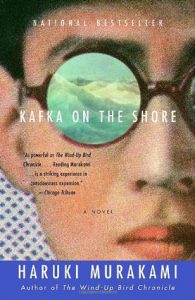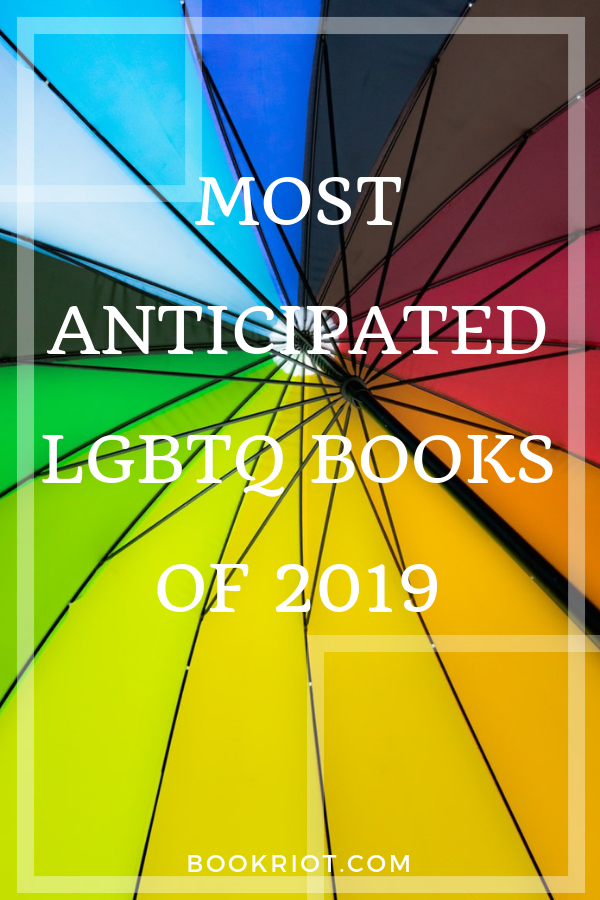We know plenty of people who have had their fill of celebrations over the past month or so, dear readers. For many of us, the beginning of January is a terrific time to build a pillow fort and snuggle up with a good book and some comfort food. If, however, you are looking for some fun ways to keep the party going, here are a few suggestions for some quirky national days in January to celebrate.
January 6: National Shortbread Day: Check out the Walker’s Shortbread website for more information, and here for a quick shortbread recipe to try yourself!
January 11: National Milk Day: Said to commemorate the day that the first milk deliveries in glass bottles began in the United States in 1878, as stated by Alexander Campbell of the New York Dairy Company. In 1915, The International Association of Milk Inspectors submitted a request, but the day was never officially ratified. Nevertheless, any day is a good day for a celebration, right?
January 13: National Rubber Duck Day: According to a 1973 Sesame Street calendar, Rubber Duckie’s Birthday is January 13 so around the country it’s National Rubber Ducky Day!
January 14: Ratification Day: Commemorating the ratification of the Treaty of Paris, which ended the American Revolution. Every year in honor of this day, there is a ceremony at the State House in Annapolis, Maryland where the treaty was signed, and a flag in the design that was displayed at the time of the signing of the Treaty of Paris flies over the State House.
January 21: National Squirrel Appreciation Day: Established by by Christy Hargrove from Asheville, North Carolina on January 21, 2001, because squirrels need some love, too!
And now, on to the books, dear readers!

 The Frame-Up: Meghan Scott Molin launches a new mystery series in style in this fun and delightfully nerdy new novel. MG Martin works as a writer for the comic book company she idolized as a kid. But despite her love of hooded vigilantes, MG prefers her comics stay on the page. But when someone in LA starts recreating crime scenes from her favorite comic book, MG is the LAPD’s best—and only—lead. She recognizes the golden arrow left at the scene as the calling card of her favorite comic book hero. But superheroes aren’t real. Are they? When too-handsome-for-his-own-good Detective Kildaire asks for her comic book expertise, MG is more than up for the adventure. Unfortunately, MG has a teeny little tendency to not follow rules. And her off-the-books sleuthing may land her in a world of trouble. Because for every superhero, there is a supervillain. And the villain of her story may be closer than she thinks. This is a book for mystery lovers and comic book fans alike that earned a starred review from Publisher’s Weekly, who called it a “stellar first novel…Molin’s clever humor enhances the inventive plot. Readers will eagerly await the sequel.”
The Frame-Up: Meghan Scott Molin launches a new mystery series in style in this fun and delightfully nerdy new novel. MG Martin works as a writer for the comic book company she idolized as a kid. But despite her love of hooded vigilantes, MG prefers her comics stay on the page. But when someone in LA starts recreating crime scenes from her favorite comic book, MG is the LAPD’s best—and only—lead. She recognizes the golden arrow left at the scene as the calling card of her favorite comic book hero. But superheroes aren’t real. Are they? When too-handsome-for-his-own-good Detective Kildaire asks for her comic book expertise, MG is more than up for the adventure. Unfortunately, MG has a teeny little tendency to not follow rules. And her off-the-books sleuthing may land her in a world of trouble. Because for every superhero, there is a supervillain. And the villain of her story may be closer than she thinks. This is a book for mystery lovers and comic book fans alike that earned a starred review from Publisher’s Weekly, who called it a “stellar first novel…Molin’s clever humor enhances the inventive plot. Readers will eagerly await the sequel.”
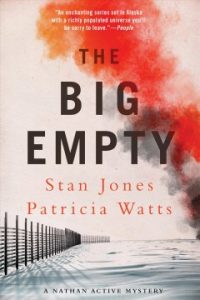 The Big Empty: Stan Jones and Patricia Watts bring the remote beauty of Alaska to life in their mystery series featuring Chukchi police chief Nathan Active. In this sixth outing, Active is asked to investigate a plane crash by his close friend, Cowboy Decker. Evie Kavoonah, a young mother-to-be, and her fiancé, Dr. Todd Brenner were flying when their bush plane ran out of gas and hit a ridge, instantly killing them both. Evie was like a daughter to Cowboy, who trained her to fly, and he insists there’s no way his protégée made a fatal mistake that day. Nathan reluctantly plays along and discovers that Cowboy’s instincts are correct—the malfunction that led to the crash was carefully planned, and several people in the village have motives for targeting the pair. Meanwhile, Nathan’s wife, Gracie, is pregnant, but so scarred by memories of domestic abuse that she isn’t sure she should have the baby. Nathan must support her and their adopted daughter, Nita, while managing an increasingly complex and dangerous murder case. Though this is an ongoing series, new readers will find a good amount to enjoy here. Booklist gave it a favorable review, noting “Jones’s and coauthor Watts’s prose has been called muscular and stark, but it has an inviting, cinematic quality to it as well. A well-constructed mystery recommended for fans of C.J. Box and Craig Johnson.”
The Big Empty: Stan Jones and Patricia Watts bring the remote beauty of Alaska to life in their mystery series featuring Chukchi police chief Nathan Active. In this sixth outing, Active is asked to investigate a plane crash by his close friend, Cowboy Decker. Evie Kavoonah, a young mother-to-be, and her fiancé, Dr. Todd Brenner were flying when their bush plane ran out of gas and hit a ridge, instantly killing them both. Evie was like a daughter to Cowboy, who trained her to fly, and he insists there’s no way his protégée made a fatal mistake that day. Nathan reluctantly plays along and discovers that Cowboy’s instincts are correct—the malfunction that led to the crash was carefully planned, and several people in the village have motives for targeting the pair. Meanwhile, Nathan’s wife, Gracie, is pregnant, but so scarred by memories of domestic abuse that she isn’t sure she should have the baby. Nathan must support her and their adopted daughter, Nita, while managing an increasingly complex and dangerous murder case. Though this is an ongoing series, new readers will find a good amount to enjoy here. Booklist gave it a favorable review, noting “Jones’s and coauthor Watts’s prose has been called muscular and stark, but it has an inviting, cinematic quality to it as well. A well-constructed mystery recommended for fans of C.J. Box and Craig Johnson.”
 Eighteen Below: Another mystery series with a great sense of place, Stefan Ahnhem’s Fabian Risk novels transform the beauty of Sweden into a character in and of itself. This third book in the series opens on a hot summer’s day, as the police chase a speeding car through the streets of Helsingborg. When they reach the bridge, the driver keeps going straight into the cold, dark waters of the Öresund strait. The body recovered from the wreck is that of Peter Brise, one of the city’s richest tech entrepreneurs. Fabian Risk and his team are confident this is suicide. Young, rich, successful―Brise just didn’t know how to ask for help. But then the autopsy reveals something unexpected. Brise was already dead when his car crashed. He’d been brutally murdered two months ago. His body frozen in perfect condition, at eighteen degrees below zero…Something doesn’t match up. And when a string of other odd murders and unusual behavior come to light in the area, Fabian Risk takes the case. This is a case that grows darker and darker with each twist, giving Kirkus Reviews cause to cheer, “Hats off to Ahnhem for creating a villain more powerful than the franchise team charged with bringing him in.”
Eighteen Below: Another mystery series with a great sense of place, Stefan Ahnhem’s Fabian Risk novels transform the beauty of Sweden into a character in and of itself. This third book in the series opens on a hot summer’s day, as the police chase a speeding car through the streets of Helsingborg. When they reach the bridge, the driver keeps going straight into the cold, dark waters of the Öresund strait. The body recovered from the wreck is that of Peter Brise, one of the city’s richest tech entrepreneurs. Fabian Risk and his team are confident this is suicide. Young, rich, successful―Brise just didn’t know how to ask for help. But then the autopsy reveals something unexpected. Brise was already dead when his car crashed. He’d been brutally murdered two months ago. His body frozen in perfect condition, at eighteen degrees below zero…Something doesn’t match up. And when a string of other odd murders and unusual behavior come to light in the area, Fabian Risk takes the case. This is a case that grows darker and darker with each twist, giving Kirkus Reviews cause to cheer, “Hats off to Ahnhem for creating a villain more powerful than the franchise team charged with bringing him in.”
 Housegirl: This is a new-to-us book that we’re really excited to feature here today. Michael Donkor’s work is a moving and unexpectedly funny exploration of friendship and family, as three women forge their way in a complicated world. Belinda knows how to follow the rules. As a housegirl, she has learned the right way to polish water glasses, to wash and fold a hundred handkerchiefs, and to keep a tight lid on memories of the village she left behind when she came to Kumasi. Mary is still learning the rules. Eleven-years-old and irrepressible, the young housegirl-in-training is the little sister Belinda never had. Amma has had enough of the rules. A straight-A student at her exclusive London school, she has always been the pride of her Ghanaian parents―until now. Watching their once-confident teenager grow sullen and wayward, they decide that sensible Belinda is the shining example Amma needs. So Belinda must leave Mary behind as she is summoned from Ghana to London, where she tries to impose order on her unsettling new world. As summer turns to autumn, Belinda and Amma are surprised to discover common ground. But when the cracks in their defenses open up, the secrets they have both been holding tightly threaten to seep out. NPR provided a fascinating review of this novel, explaining, “I hate novels because too often, I know exactly where the story is heading, where the characters are heading. I loved Housegirl because Michael Donkor’s storytelling and character building were so exquisite…Two days after I finished the book, I found myself actually missing [them]. This is a rare accomplishment.”
Housegirl: This is a new-to-us book that we’re really excited to feature here today. Michael Donkor’s work is a moving and unexpectedly funny exploration of friendship and family, as three women forge their way in a complicated world. Belinda knows how to follow the rules. As a housegirl, she has learned the right way to polish water glasses, to wash and fold a hundred handkerchiefs, and to keep a tight lid on memories of the village she left behind when she came to Kumasi. Mary is still learning the rules. Eleven-years-old and irrepressible, the young housegirl-in-training is the little sister Belinda never had. Amma has had enough of the rules. A straight-A student at her exclusive London school, she has always been the pride of her Ghanaian parents―until now. Watching their once-confident teenager grow sullen and wayward, they decide that sensible Belinda is the shining example Amma needs. So Belinda must leave Mary behind as she is summoned from Ghana to London, where she tries to impose order on her unsettling new world. As summer turns to autumn, Belinda and Amma are surprised to discover common ground. But when the cracks in their defenses open up, the secrets they have both been holding tightly threaten to seep out. NPR provided a fascinating review of this novel, explaining, “I hate novels because too often, I know exactly where the story is heading, where the characters are heading. I loved Housegirl because Michael Donkor’s storytelling and character building were so exquisite…Two days after I finished the book, I found myself actually missing [them]. This is a rare accomplishment.”
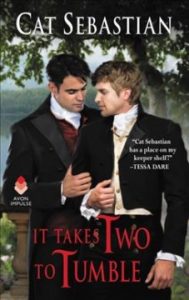 It Takes Two to Tumble: Cat Sebastian’ historical m/m romances are always an emotional, funny, and clever, and this newest addition to her Seducing the Sedgewicks series is no exception, turning a beloved romance trope on its ear with rare skill. After an unconventional upbringing, Ben Sedgewick is perfectly content with the quiet, predictable life of a country vicar, free of strife or turmoil. When he’s asked to look after an absent naval captain’s three wild children, he reluctantly agrees, but instantly falls for the hellions. And when their stern but gloriously handsome father arrives, Ben is tempted in ways that make him doubt everything. Phillip can’t wait to leave England’s shores and be back on his ship, away from the grief that haunts him. But his children have driven off a succession of governesses and tutors and he must set things right. The unexpected presence of the cheerful, adorable vicar sets his world on its head and now he can’t seem to live without Ben’s winning smiles or devastating kisses. Amidst the turmoil of runaway children, a plot to blackmail Ben’s family, and torturous nights of pleasure, Ben and Phillip must decide if a safe life is worth losing the one thing that makes them come alive. Booklist gave this title a starred review, noting “Sebastian’s latest elegantly and eloquently written Regency historical… slowly unfolds into an unforgettable love story that manages to be both sweetly romantic and sizzlingly sensual at the same time, demonstrating once again why Sebastian is one of the brightest new stars in the romance genre.”
It Takes Two to Tumble: Cat Sebastian’ historical m/m romances are always an emotional, funny, and clever, and this newest addition to her Seducing the Sedgewicks series is no exception, turning a beloved romance trope on its ear with rare skill. After an unconventional upbringing, Ben Sedgewick is perfectly content with the quiet, predictable life of a country vicar, free of strife or turmoil. When he’s asked to look after an absent naval captain’s three wild children, he reluctantly agrees, but instantly falls for the hellions. And when their stern but gloriously handsome father arrives, Ben is tempted in ways that make him doubt everything. Phillip can’t wait to leave England’s shores and be back on his ship, away from the grief that haunts him. But his children have driven off a succession of governesses and tutors and he must set things right. The unexpected presence of the cheerful, adorable vicar sets his world on its head and now he can’t seem to live without Ben’s winning smiles or devastating kisses. Amidst the turmoil of runaway children, a plot to blackmail Ben’s family, and torturous nights of pleasure, Ben and Phillip must decide if a safe life is worth losing the one thing that makes them come alive. Booklist gave this title a starred review, noting “Sebastian’s latest elegantly and eloquently written Regency historical… slowly unfolds into an unforgettable love story that manages to be both sweetly romantic and sizzlingly sensual at the same time, demonstrating once again why Sebastian is one of the brightest new stars in the romance genre.”
Until next week, beloved patrons–happy reading!
 One Hundred Years of Solitude by Gabriel García Márquez
One Hundred Years of Solitude by Gabriel García Márquez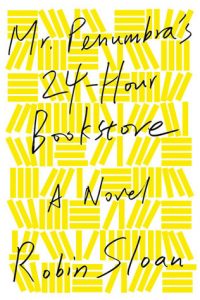
 The Brief and Wondrous Life of Oscar Wao by Junot Díaz
The Brief and Wondrous Life of Oscar Wao by Junot Díaz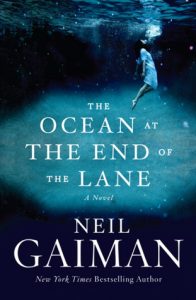
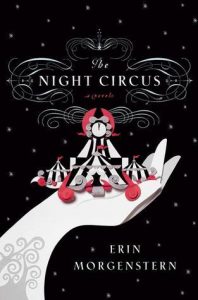 The Night Circus by Erin Morgenstern
The Night Circus by Erin Morgenstern